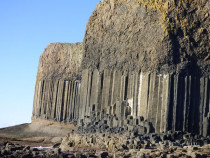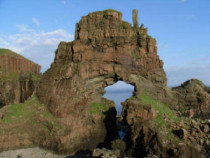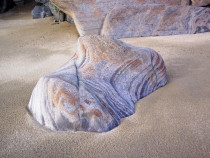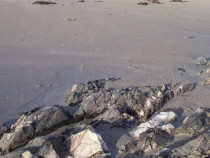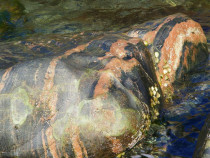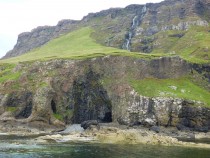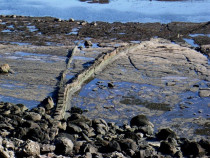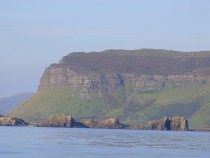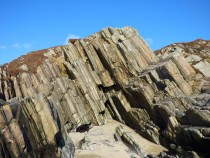The Geology of Mull
Click on Image to enlarge
Mull is constructed rather like a multi-tiered wedding cake. Thick layers of basalt lava sit on top of a complicated basement of much older rocks which peep out around the edges of Mull rather like the silver base does on the lowest wedding cake tier. Geologists love Mull because it has such a long and interesting history (its oldest rocks on Iona are about 2000 million years old), and it has unique structures and rocks found nowhere else in the world (such as the Loch Ba Ring Dyke and felsite).
Mull has not always been in its present position and form. Over geological time it has undergone enormous changes. Mull's oldest rocks formed way south in the
southern hemisphere and Mull (in common with the British Isles) has gradually drifted northwards to its present day position. (In the process of continental drift.) Its rocks preserve details of the climatic zones that it passed through on its northward journey. For example, if you stand on the rocky shore opposite Inch Kenneth at Gribun you will be standing on sandstones deposited in a desert region at the same sort of latitude and rather like the Persian Gulf today. Most of Mull is made of lava poured out of fissure volcanoes when the North Atlantic was forming and Mull was torn apart from its 'neighbour' Greenland as the vast super-continent which once joined North America and Europe divided. The molten lava which erupted from about 60 to 50 million years ago forms Mull's
'stepped' tablelands. Into these, at a later stage, intrusions of other 'rocks formed by fire' took place, forming the mountains of Mull's famous Central Igneous Complex. Volcanic explosions and intense earthquakes shook Mull atthat time and one of the old fault lines, the Great Glen fault is still occasionally active.
Mull's final shape has largely been carved by huge glaciers which only melted away from Mull 10,000 years ago leaving deep 'U' shaped valleys between the mountains and long glaciated lochs both freshwater and marine. Mull doesn't have any precious gems at the surface, but geologists know that deep below Mull, in the earth's mantle there must be priceless minerals at this spot, but the temperature at that depth would melt any drills probing for them! Mull with its incredible history and unique rocks and intrusions is a 'Mecca' for geologists who travel from all over the world for field work.
All of the photographs have been taken by John
Information compiled by and shared with the courtesy of Rosalind Jones B.Sc. F.G.S. Mull in the Making. The story of Mull and Iona's incredible 2800 million year geological history, "It caters for the non geologist drawn to Mull for the space and solitude which the island affords." Eric Robinson, Geologist Association
Updated 30/03/21
Seaview 2000-2021


